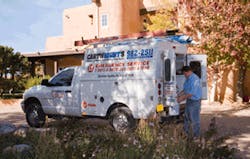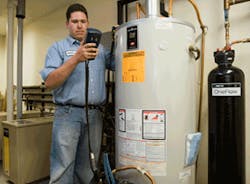“Last winter we had a few days where the temperature hung around -32°F,” said Mario Larranaga, senior field technician for Cartwright Plumbing, Heating and Cooling, based in Santa Fe, N.M. “This summer, the mercury rose to 110°F for a few weeks.”
A 142 degree swing in temperature puts incredible strain on mechanical equipment. If energy efficiency is a key consideration, simpler technology can sometimes be the answer. An evaporative cooler, or “swamp cooler,” is an energy-wise approach to home cooling in arid regions. Yet, groundwater quality issues frequently plague areas where underground reserves are tapped heavily.
Desert air conditioning
Cartwright has been serving the Santa Fe area since 1939. Managers there have long since come to terms with the local climate and water issues. The firm’s 20 technicians split their talent equally between commercial and residential work. New construction, on both fronts, has slowed considerably, so service and retrofit work have combined to keep the company in good stead.
About 20 miles from the company’s headquarters is an eight-year-old home with mechanical equipment familiar to Cartwright installers. Like many properties in the area, the 2,600-sq.ft., adobe-style home was routinely beset with problems tied to poor water quality. The well water is hard on appliances, large and small. According to Larranaga, even city water in the area comes into the house with eight grains of hardness per gallon.
Although eight grains may not cause catastrophic problems in most households, this home has several evaporative cooling units. Many homes in arid regions use this energy-efficient means of air conditioning, and the equipment isn’t fond of scale.
Water runs down pads, through which air is drawn, and into the home, cooling the air and introducing some moisture to increase comfort. In a hot, dry climate, the systems use far less energy than a comparable refrigerative air conditioner. That is, unless the pads become dirty or clogged.
“Our AC system keeps the house comfortable and isn’t expensive to run,” said homeowner Felice Gonzales. The Champion roof-mounted evaporative units are used five months out of the year. “The swamp-coolers don’t run constantly, like a traditional AC system,” said Gonzales. “We only use them when days are really hot.”
Salt-free water softening
Larranaga tried different kinds of salt, and even a different softener, but could never get the water hardness low enough to keep the cooling systems from scaling-up. At the time, Cartwright had never used anything other than salt-based water softeners to treat hard water. After a regional distributor held a training class on a new, chemical-free anti-scale technology, the Gonzales home seemed like the perfect guinea pig to Larranaga.
Watts’ OneFlow anti-scale central treatment system uses template-assisted crystallization (TAC) technology. TAC falls into a category of water treatment often referred to as physical water treatment (PWT).
TAC media starts out as polymeric beads (resin) in the 20 to 40 mesh size range. Catalytically active sites, or templates, are “imprinted” or coated on the bead surface through a batch-coating process.
The template influences the water solution at localized sites, on bead surfaces, forcing hardness ions and their counter-ions (bicarbonates) to combine to form small, inert “seed crystals.” This process, called nucleation, occurs when dissolved molecules, or ions, dispersed throughout a solution gather to create clusters in the sub-micron size range.
The seeds provide an enormous area for preferential growth of remaining hardness ions still in solution. The remaining dissolved ions attach to the seed crystals and continue harmlessly downstream.
“We like the OneFlow system because it doesn’t add chemicals to the ground water, and it isn’t carcinogenic,” said Gonzales. Add to that, it doesn’t draw any electric from the grid. The 16 GPM unit at the Gonzales residence only takes up as much space in the mechanical room as the old salt system’s resin bed tank.
It’s been two years since the swap-out, and the pads haven’t been changed once. Since then, Cartwright has installed about 20 residential OneFlow systems to combat problems very similar to those experienced at the Gonzales residence.
Hot water tune-up
Hard water had taken its toll on the original water heater as well. Its efficiency had been tapering off as scale built up. After only eight years of service, scale had all but rendered the tank useless. Once the new water treatment system was installed, it was time for a new water heater.
“We installed a 75-gal., gas-fired Bradford White unit,” said Larranaga. “We’ve used Bradford White for years. They make a great product, and our distributor, Perry Supply, is great to work with.”
“By maintaining the swamp cooler, installing an energy efficient water heater, and protecting that efficiency with environmentally-friendly scale prevention technology, we were able to give the Gonzales’ peace of mind,” said Larranaga. “They wanted to impact the natural environment as little as possible, while being comfortable and reducing energy costs. All three should be the goals of any homeowner.”


